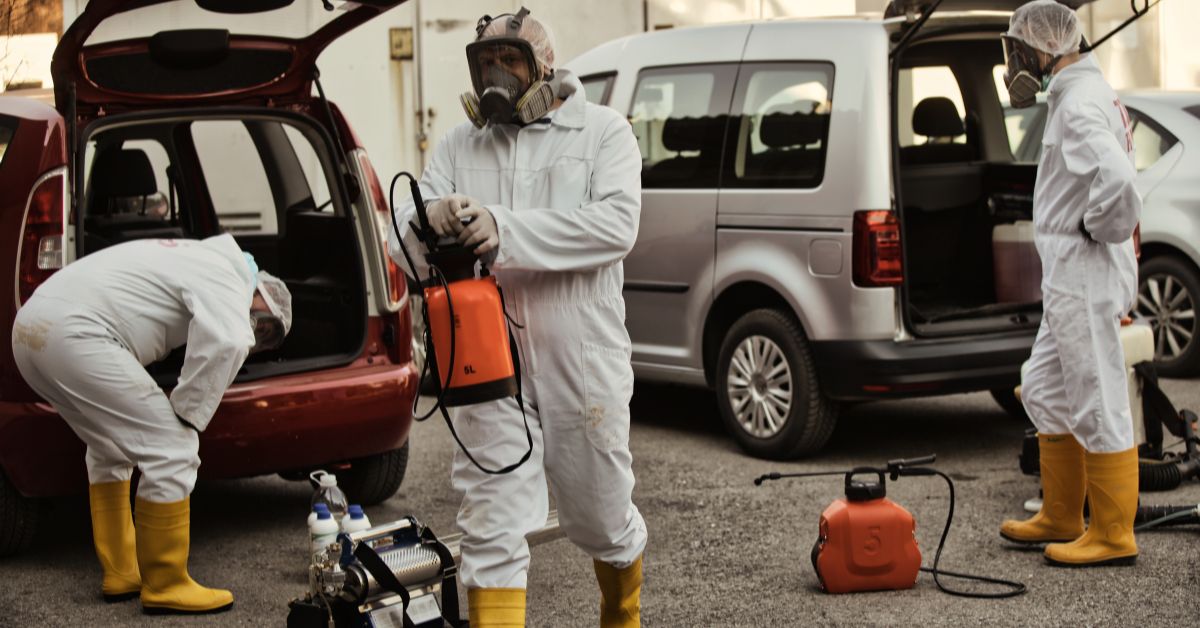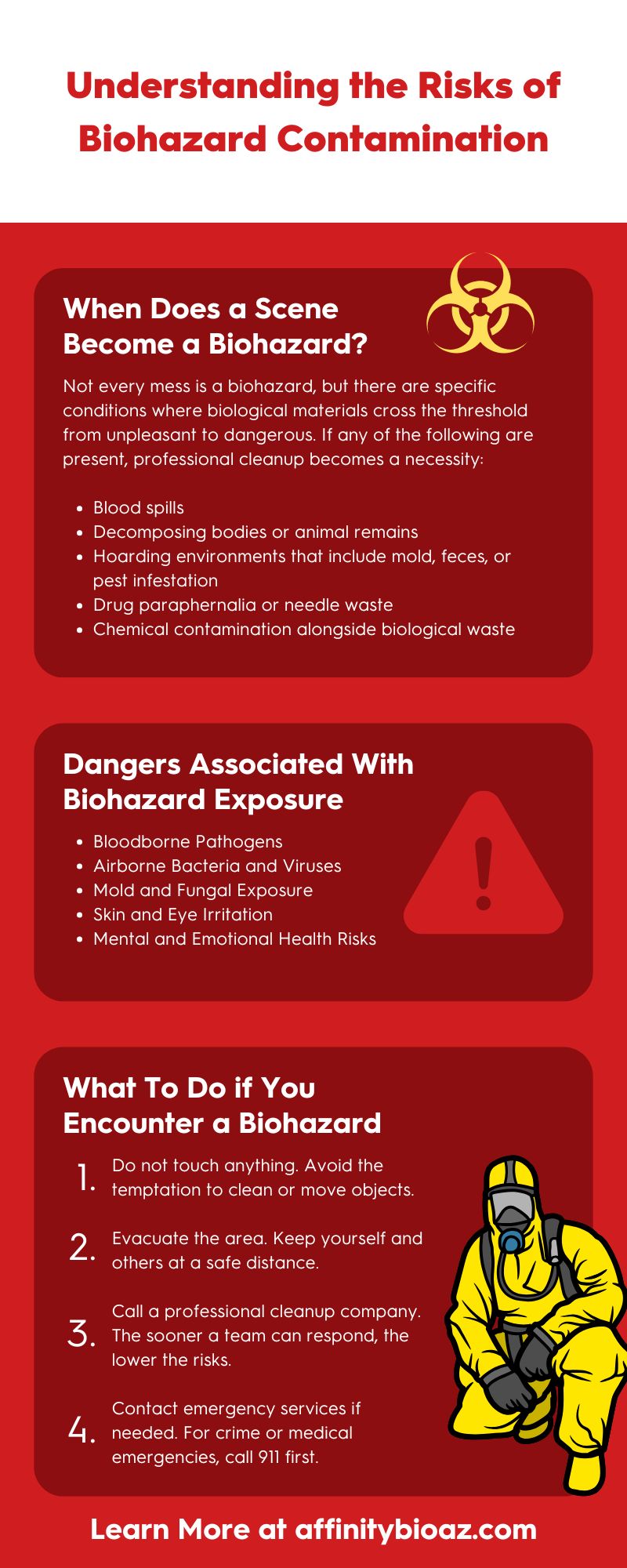
When accidents occur, the resulting biohazards can pose a significant threat to human health and safety. You might have to deal with anything from bloodborne pathogens to decomposition byproducts. Without proper assessment and remediation, the situation can escalate quickly and put you at risk.
This comprehensive guide explores the critical aspects of biohazard contamination, enabling you to handle incidents effectively.
What Are Biohazards?
Understanding the risks of biohazard contamination empowers you to make informed decisions about professional remediation services. However, you first need to know what biohazards actually are. Biohazards, also referred to as biological hazards, are any substances that pose a threat to human health due to their potential to carry disease-causing microorganisms. These hazards may include human blood, bodily fluids, animal waste, microbiological waste, and similar substances.
When Does a Scene Become a Biohazard?
Not every mess is a biohazard, but there are specific conditions where biological materials cross the threshold from unpleasant to dangerous. If any of the following are present, professional cleanup becomes a necessity:
- Blood spills
- Decomposing bodies or animal remains
- Hoarding environments that include mold, feces, or pest infestation
- Drug paraphernalia or needle waste
- Chemical contamination alongside biological waste
If property owners or building managers attempt to clean up these materials without the proper gear and training, they can inadvertently expose themselves and others to significant health risks.
Dangers Associated With Biohazard Exposure
Exposure to biohazards can be extremely dangerous to human health. Here are a few of the biggest hazards.
Bloodborne Pathogens
One of the most immediate risks in biohazard cleanup is exposure to bloodborne pathogens (BBPs). These are microorganisms present in human blood and certain bodily fluids that can lead to disease in humans. Common BBPs include:
- Hepatitis B (HBV): A highly contagious virus that affects the liver and can lead to chronic infection
- Hepatitis C (HCV): Transmitted primarily through blood-to-blood contact and often causes liver damage and long-term complications
- Human immunodeficiency virus (HIV): Although fragile outside the body, HIV remains a serious risk if blood enters cuts or mucous membranes.
Airborne Bacteria and Viruses
Not all biohazards involve direct contact. In some cases, airborne transmission presents a serious risk. When biological materials decompose or are disturbed, tiny particles can become aerosolized and enter the respiratory system. This can happen in hoarding environments, crime scenes, or after a prolonged period of decomposition.
Examples of airborne biohazards include tuberculosis (TB), COVID-19, influenza, and C. diff spores from gastrointestinal infections, which are extremely persistent and resistant to normal disinfectants. Without professional-grade filtration, ventilation, and personal protection, these microbes can spread rapidly and infect unsuspecting individuals.
Mold and Fungal Exposure
In cases of water damage or decomposition, mold growth is common and poses a significant health hazard. Toxic black mold is especially dangerous and requires specialized containment and removal.
Prolonged mold exposure can lead to respiratory infections, chronic coughing or sneezing, fatigue or neurological symptoms, or worsened asthma or COPD symptoms. Children, older adults, and immunocompromised individuals are particularly vulnerable to mold.
Skin and Eye Irritation
Biological waste contains a mixture of bacteria, viruses, and toxic compounds that can cause immediate and delayed reactions when it comes into contact with human skin or mucous membranes.
Exposure to these substances may result in rashes, chemical burns, allergic reactions, or painful infections. Even brief contact with contaminated surfaces can introduce harmful microbes into the body through microscopic breaks in the skin. These infections may not always exhibit symptoms immediately but can escalate rapidly, sometimes necessitating medical attention or antibiotic treatment.
The eyes are especially vulnerable. When fluids or aerosolized particles become airborne—something that frequently happens during DIY cleaning efforts—there is a risk of splashing or drifting into the eyes, where pathogens can enter the body through mucous membranes. Eye exposure can lead to inflammation, conjunctivitis, and in more severe cases, the transmission of bloodborne diseases.
Mental and Emotional Health Risks
In addition to physical illness, biohazard exposure often occurs in traumatic or distressing environments. For instance, being exposed to the aftermath of a violent crime or unattended death can trigger intense emotional reactions including anxiety and panic attacks, depression, PTSD-like symptoms, and intrusive memories or nightmares.
Untrained individuals should not be forced to relive trauma by cleaning up scenes involving a loved one. Professionals approach these environments with empathy and objectivity, reducing the emotional burden on affected families or property managers.
What To Do if You Encounter a Biohazard
If you encounter a situation where biological materials may be present, follow these steps:
- Do not touch anything. Avoid the temptation to clean or move objects.
- Evacuate the area. Keep yourself and others at a safe distance.
- Call a professional cleanup company. The sooner a team can respond, the lower the risks.
- Contact emergency services if needed. For crime or medical emergencies, call 911 first.
Why Professional Cleanup Is Worth It
In the aftermath of a traumatic or hazardous event, hiring a professional biohazard cleanup is the best option. Biological contaminants don’t just disappear over time. In fact, the longer they’re left untreated, the more dangerous they become. Bacteria multiply, odors intensify, and contaminants seep into surfaces that standard cleaning products can’t penetrate. A professional team has the tools and training to respond quickly and thoroughly, reducing health risks and long-term property damage.
One of the key advantages of professional cleanup is the speed and precision of response. For example, the team at Affinity Bio Solutions is available 24/7, providing immediate action when time matters most. Affinity Bio Solutions is Arizona’s trusted name in trauma and biohazard cleanup. With years of field experience, we handle each job with care, professionalism, and attention to detail.
Dealing with a biohazard scene is about reclaiming safety and peace of mind. At Affinity Bio Solutions, we recognize that understanding the risks of biohazard contamination is essential to making informed, safe decisions. Our trained team follows strict safety protocols and works discreetly and efficiently to return homes, businesses, and public spaces to a safe and habitable condition.
If you need blood and body fluid remediation, don’t take chances with your health. Call Affinity Bio Solutions, and let us handle the unseen risks and emotional weight of the job. Your safety is our priority.

